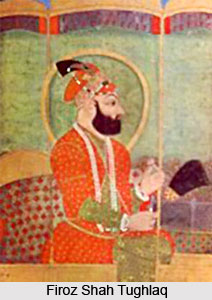 There were several reasons which led to the downfall of the Tughlaq Empire. The Tughlaqs established most extensive empire among the Delhi Sultanate. Ghiyas- ud- din took advantage of the conquest of the south and annexed larger part of it. Muhammad Bin Tughlaq contributed most towards extension of the Empire both as a prince and a Sultan. But the process of disintegration began during his reign. The annexation of the south, the failures of Muhammad Tughlaq, the weakness of Firoz Shah Tughlaq, the incompetence of his successors, the incompetence and demoralization of the nobility and the invasion of Timur were the chief factors responsible for the downfall of this vast Empire.
There were several reasons which led to the downfall of the Tughlaq Empire. The Tughlaqs established most extensive empire among the Delhi Sultanate. Ghiyas- ud- din took advantage of the conquest of the south and annexed larger part of it. Muhammad Bin Tughlaq contributed most towards extension of the Empire both as a prince and a Sultan. But the process of disintegration began during his reign. The annexation of the south, the failures of Muhammad Tughlaq, the weakness of Firoz Shah Tughlaq, the incompetence of his successors, the incompetence and demoralization of the nobility and the invasion of Timur were the chief factors responsible for the downfall of this vast Empire.
Ghiyas- ud- din Tughlaq adopted the policy of annexing the conquered territories of the south which was led to perfection by Muhammad Tughlaq. But this measure was against the permanent interest of the Empire. Due to the lack of proper means of transport it was difficult for the rulers of the north to keep the south under his control for long. Thus the south became independent during the later period of Muhammad Tughlaq. The conquest of the south brought no advantages to the Tughlaqs. On the contrary, it adversely affected the resources and the strength of the Empire.
Muhammad Tughlaq failed both in his internal and foreign policy. While Bengal and the south regained independence and the hold of the Delhi Sultanate became weak over Gujarat and Sindh, no significant territory could be added to the Empire permanently. All the schemes of Muhammad Tughlaq failed miserably and brought economic ruin to the Empire. Besides, his policies and severe measures resulted in widespread revolts at several places which taxed further the energy and resources of the empire.
Firoz Tughlaq succeeded in restoring the economic prosperity of the Empire and did many useful works for public welfare. But his imprudent generosity, relaxity in administration, slave system, policy of intolerance towards the Hindus, restoration of prestige and influence of the Ulema and the negligence to build up military strength of the Empire went against the interests of the state. Firoz Shah Tughlaq failed to restore the prestige and power of the Delhi Sultanate.
There were no competent successors after Firoz Tughlaq and no one deserved to be the Sultan of Delhi. His third son Muhammad was pleasure loving and was devoid of his reign to the throne. Firoz nominated Tughlaq Shah, son of his late eldest son as his successor. Prince Muhammad fought both against Tughlaq Shah and his successor Abu Bakr. Though he succeeded but conflicts between royal princes gave chance to nobles at the court and the governors of provinces to increase their powers and influences at the cost of successive Sultans. Thus the later Tughlaqs proved incompetent and ineffective in matters of the state and Sultan Nasir- ud- din Mahmud, the last ruler of the dynasty met an ignoble death.
Nobles and provincial governors of latter Tughlaqs took advantage of the incompetence of the rulers. Those who were ambitious and competent established independent kingdoms out of the ruins of the Empire and those who were incompetent were struck to the court engaging themselves in corruption and luxuries. None of them were capable and whosoever was competent was disloyal to the Sultan and therefore worked against the interest of the Delhi Sultanate.
The final blow to the power and prestige of the Tughlaq Empire was given by Timur. He destroyed the Delhi Sultanate and the dynasty of the Tughlaqs. Though Tughlaq dynasty had lost its prestige prior to the invasion of Timur but after his invasion it was thoroughly destroyed forever.
Thus different factors participated in bringing about the downfall of the Tughlaq Dynasty. The process of disintegration started with the reign of Muhammad Tughlaq, Firoz Tughlaq in his own way contributed towards it and during the period of the later Tughlaqs it completed itself.



















